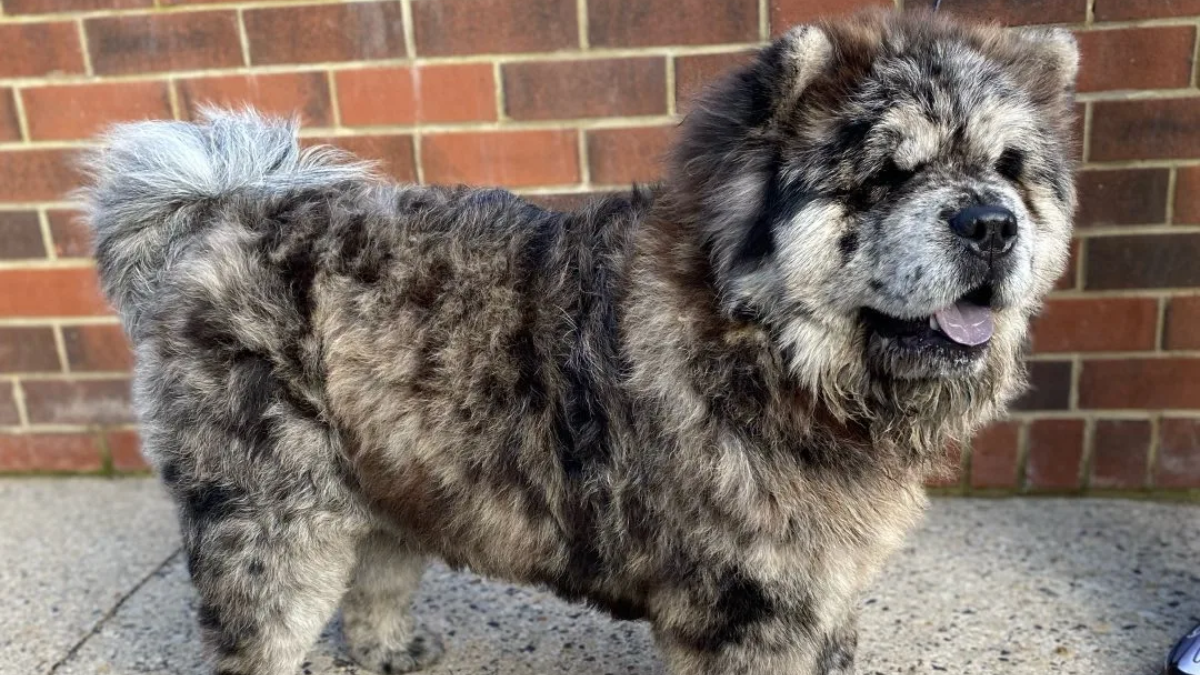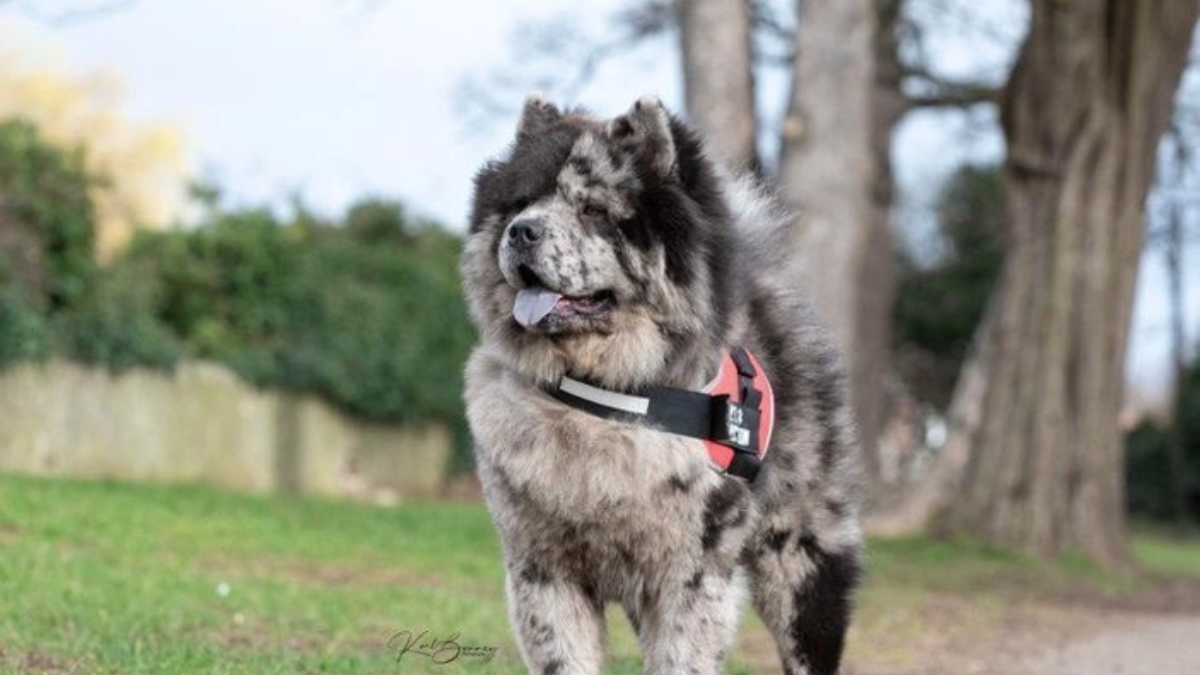The Blue Merle Chow is a rare and unique breed of dog that has captured the hearts of many dog lovers. This breed is a variation of the Chow Chow, which is known for its distinctive blue-black tongue and thick fur coat. The Blue Merle Chow, however, has a coat that is a mix of blue, black, and white, giving it a striking appearance that is sure to turn heads.

Despite its striking appearance, the Blue Merle Chow is not recognized by all kennel clubs as a separate breed. Some consider it to be a variation of the Chow Chow, while others see it as a separate breed altogether. Regardless of its classification, the Blue Merle Chow is a loyal and affectionate companion that is sure to bring joy to any household. Its unique appearance and charming personality make it a popular choice for dog lovers who are looking for something a little different.
Origins and History
Ancient Breed Roots
The Chow Chow is an ancient breed that originated in China. It is believed that the breed has been around for over 2,000 years and was used for a variety of purposes, including hunting, herding, and guarding. The breed was highly valued in China and was often given as a gift to royalty.
The exact origins of the Chow Chow are unclear, but it is thought that the breed may have descended from the Tibetan Mastiff. The breed was originally known as the Tang Quan, which means "Dog of the Tang Empire," and was later renamed the Chow Chow.
Development of the Blue Merle Variety
The Blue Merle Chow is a relatively new variety of the breed. It is believed that the Blue Merle coloration was introduced to the breed through crossbreeding with other breeds, such as the Shar Pei and the Australian Shepherd.
The Blue Merle variety is characterized by its distinctive coat, which is a combination of blue, black, and gray. This coloration is caused by a dilution gene, which affects the production of melanin in the coat.
Today, the Blue Merle Chow is a popular variety of the breed and is recognized by many kennel clubs around the world. The breed is known for its loyalty, intelligence, and independent nature, and is a popular choice for families and individuals looking for a unique and distinctive companion.
Breed Standards
AKC Recognition
The Blue Merle Chow is a recognized breed by the American Kennel Club (AKC). It was first recognized by the AKC in 1903 and is classified under the Non-Sporting Group.

Coat and Color Specifications
The Blue Merle Chow has a double coat that is thick and dense. The outer coat is coarse and straight, while the undercoat is soft and woolly. The coat should be trimmed regularly to maintain its neat appearance.
The Blue Merle Chow comes in a variety of colors, but the most distinctive feature is its blue merle coat. The blue merle coat is a combination of black, gray, and white that creates a marbled effect. The AKC breed standard allows for other coat colors such as black, red, cream, and cinnamon, but the blue merle coat is the most sought-after.
According to the AKC breed standard, the coat color should be even and solid, with no white markings except for on the chest and toes. The nose should be black, and the tongue should be blue-black.
In addition to coat color, the AKC breed standard also specifies other physical characteristics such as height, weight, and overall appearance. The Blue Merle Chow should have a sturdy and well-balanced frame, with a broad skull and a short, broad muzzle. The eyes should be dark and almond-shaped, and the ears should be small and triangular.
Overall, the Blue Merle Chow is a unique and distinctive breed with a beautiful blue merle coat. Its physical characteristics and coat color are carefully regulated by the AKC breed standard to ensure that each dog meets the desired specifications.
Physical Characteristics
Coat Patterns and Textures
The Blue Merle Chow is a breed that is known for its unique coat patterns and textures. The coat can come in both rough and smooth varieties, with the rough coat being more common. The rough coat is thick and dense, while the smooth coat is shorter and softer to the touch.

The Blue Merle Chow's coat pattern is characterized by a mix of blue and black colors, which creates a marbled effect. The blue color is usually more dominant, giving the coat a bluish-gray appearance. The coat can also have patches of tan or cream, which add to its unique appearance.
Size and Stature
The Blue Merle Chow is a medium-sized dog, with a height of 17 to 20 inches at the shoulder and a weight of 45 to 65 pounds. Despite its size, the breed is known for its sturdy build and muscular appearance.
The Blue Merle Chow has a fluffy appearance, which is accentuated by its lion-like mane. The mane is more prominent in males than females, but both genders have a thick, fluffy coat. The breed's overall appearance is regal and dignified, with a confident and alert demeanor.
In conclusion, the Blue Merle Chow is a unique and beautiful breed with a distinctive coat pattern and texture. Its sturdy build and fluffy appearance make it a popular choice among dog lovers.
Genetics and Coloration
The Merle Gene
The blue merle chow is a result of the merle gene, which causes a mottled or speckled appearance in the coat. This gene affects the distribution of pigment in the fur, causing patches of lighter and darker colors. The merle gene is dominant, meaning that a dog only needs to inherit one copy of the gene from either parent to display the merle pattern. However, if a dog inherits two copies of the merle gene, it can lead to health issues such as deafness and blindness.
The Merle gene is also known to affect the color of the eyes, often resulting in blue or partially blue eyes. The merle coat pattern can vary in intensity, with some chows displaying a subtle speckling and others having a more pronounced mottled appearance.

Impact of Dilution Gene
In addition to the merle gene, the blue merle chow also carries a dilution gene that affects the intensity of the coat color. The dilution gene causes a reduction in the amount of melanin, which is responsible for pigmentation in the fur. This can result in a lighter coat color, such as the blue-gray color seen in blue merle chows.
The dilution gene can be inherited in different forms, with homozygous dogs having two copies of the gene and heterozygous dogs having only one copy. Homozygous dogs typically have a more diluted coat color than heterozygous dogs, but they may also be more prone to health issues such as skin allergies.
Overall, the genetics of the blue merle chow are complex and can have a significant impact on the appearance and health of the dog. Understanding the role of the merle and dilution genes can help breeders produce healthy and visually striking chows with the desirable blue merle coat pattern.
Temperament and Behavior
Personality Traits
Blue Merle Chow is a breed of dog that is known for its dignified and independent personality. They are highly intelligent and can be stubborn at times, but they are also very loyal and protective of their companions. This breed is not typically aggressive, but they can be reserved around strangers and may require proper socialization to prevent shyness or fearfulness.
Blue Merle Chows are known to be excellent companions for those who are looking for a dog that is both loyal and independent. They are highly adaptable and can be comfortable living in both urban and rural environments. However, they are not recommended for families with small children, as they may not tolerate rough play or sudden movements.
Behavioral Tendencies
Blue Merle Chows are known for their calm and reserved demeanor, but they can also be playful and energetic when they are in the mood. They are not typically barkers, but they may alert their owners to the presence of strangers or unusual sounds.
This breed tends to be very independent and may not always respond to commands or training. They may require a firm and consistent hand in training, as they can be stubborn at times. However, they are highly intelligent and can be trained to perform a variety of tasks and tricks.
Overall, Blue Merle Chows are a highly intelligent and dignified breed that makes excellent companions for those who are looking for a loyal and protective dog. They may require proper socialization to prevent shyness or fearfulness, but with proper training and care, they can be a wonderful addition to any family.

Health and Wellness
Common Health Issues
As with any breed, the Blue Merle Chow may be susceptible to certain health conditions. These can include entropion, hip dysplasia, hearing impairment, and vision impairment. Additionally, there may be a risk of cryptic merle, a genetic condition that can cause hearing and vision impairment, as well as other health issues. It is important for owners to be aware of these potential health concerns and to work closely with their veterinarian to monitor their dog's health.
Responsible Breeding Practices
To help minimize the risk of health issues in Blue Merle Chows, breeders need to follow responsible breeding practices. This includes regular health screenings for both parents before breeding, as well as genetic testing to identify potential health issues. Breeders should also be aware of the risk of cryptic merle and take steps to avoid breeding dogs that may carry the gene.
When choosing a Blue Merle Chow, it is important to work with a reputable breeder who prioritizes the health and well-being of their dogs. A responsible breeder will be happy to provide health records for both parents and any puppies and will be willing to answer any questions you may have about their breeding practices.
Overall, with proper care and attention to health and wellness, the Blue Merle Chow can be a happy and healthy companion for many years to come.
Care and Maintenance
Grooming Needs
The Blue Merle Chow has a thick, double coat that requires regular grooming to keep it healthy and clean. Brushing the coat once a week helps to remove loose hair and prevent matting. During shedding season, which occurs twice a year, more frequent brushing may be necessary. A slicker brush and a metal comb are recommended for grooming this breed.
In addition to regular brushing, the Blue Merle Chow may also need to have their nails trimmed, teeth brushed, and ears cleaned. It is important to start these grooming routines early on in a puppy's life to ensure they become comfortable with the process.
Exercise and Training
The Blue Merle Chow is a medium-sized dog that requires regular exercise to maintain their health and wellbeing. Daily walks and playtime are recommended to keep this breed physically and mentally stimulated.

Training is also an important aspect of caring for a Blue Merle Chow. This breed can be strong-willed and independent, so early socialization and obedience training are essential. Positive reinforcement techniques such as treats and praise are recommended for training this breed.
It is important to note that the Blue Merle Chow may not be suitable for all households. This breed requires a significant amount of work and socialization to ensure they are well-behaved and happy. Prospective owners should carefully consider their ability to provide the necessary care and attention before bringing a Blue Merle Chow into their home.
Choosing a Blue Merle Chow
If you're considering getting a blue Merle chow, there are a few things to keep in mind before making your decision. In this section, we'll cover some important factors to consider when choosing a blue merle chow, including finding reputable breeders and considerations for potential owners.
Finding Reputable Breeders
When looking for a blue merle chow breeder, it's important to do your research to ensure that you're getting a healthy and well-bred dog. Look for breeders who are registered with reputable organizations such as the American Kennel Club (AKC) or the United Kennel Club (UKC). These organizations have strict standards for breeding practices and can help you find a breeder who follows ethical breeding practices.
You can also ask for recommendations from other chow chow owners or breeders. A good breeder will be happy to answer any questions you have and provide you with information about the dog's health, temperament, and lineage.
Considerations for Potential Owners
Before getting a blue merle chow, potential owners should consider their lifestyle and living situation. Blue merle chows are known for their loyalty and make great family pets, but they also have a strong protective instinct and can be wary of strangers. They require regular exercise and mental stimulation, so they may not be the best choice for someone with a sedentary lifestyle.

It's also important to consider the dog's grooming needs. Blue chow chows have a thick double coat that requires regular brushing to prevent matting and tangling. They also shed heavily twice a year, so potential owners should be prepared to deal with a lot of dog hair.
Finally, potential owners should be aware of the potential health issues that can affect the chow breed, such as hip dysplasia and eye problems. Reputable breeders will have their dogs screened for these issues and provide health guarantees for their puppies.
In conclusion, choosing a blue merle chow requires careful consideration and research. By finding a reputable breeder and considering your lifestyle and the dog's needs, you can ensure that you're getting a healthy and happy companion for years to come.
Conclusion:
In conclusion, the Blue Merle Chow is a unique and stunning variation of the Chow Chow breed. While not recognized by all kennel clubs, it is still a popular and sought-after choice for dog lovers who appreciate its striking appearance and loyal personality.
As with all Chow Chows, the Blue Merle Chow requires early socialization and consistent training to prevent any potential aggression or stubbornness. However, with proper care and attention, they can make wonderful pets for the right owner.
It is important to note that the Blue Merle coloring is not exclusive to the Chow Chow breed, and can also be found in other breeds such as the Australian Shepherd and Border Collie. Additionally, the Merle gene can sometimes cause health issues such as deafness and blindness, so it is important to only purchase from reputable breeders who prioritize the health and well-being of their dogs.
Overall, the Blue Merle Chow is a fascinating and beautiful addition to the world of dog breeds, and one that is sure to turn heads and capture hearts.
Frequently Asked Questions (FAQs)
- What health concerns should be considered when adopting a blue merle Chow Chow?
- Like all dog breeds, Chow Chows are prone to certain health issues. Blue merle Chows may be more susceptible to eye problems such as cataracts, glaucoma, and entropion. They may also be prone to hip dysplasia, elbow dysplasia, and thyroid issues. It is important to research the breed and the specific health concerns associated with blue merle Chows before adopting one.
- How can one identify a reputable breeder for blue merle Chow Chow puppies?
- When looking for a breeder, it is important to do your research and ask questions. A reputable breeder will be happy to answer any questions you have about the breed and their breeding practices. Look for breeders who health test their dogs, provide a clean and safe environment for the puppies, and are willing to provide references from previous customers.
- What is the typical price range for a blue Merle Chow Chow puppy?
- The price of a blue Merle Chow Chow puppy can vary depending on the breeder and location. On average, you can expect to pay anywhere from $1,500 to $3,000 for a blue merle Chow Chow puppy. However, it is important to remember that price should not be the only factor when choosing a breeder or puppy.
- How does the Merle gene affect the coat and appearance of a Chow Chow?
- The merle gene is responsible for the blue merle coat color in Chow Chows. This gene can also affect the pigmentation of the nose and eyes, resulting in blue or partially blue eyes and a pink or mottled nose. The Merle gene can also cause white markings on the coat.
- Can Blue Merle Chow Chows be registered with major kennel clubs?
- Yes, Blue Merle Chow Chows can be registered with major kennel clubs such as the American Kennel Club (AKC) and the United Kennel Club (UKC). However, it is important to note that some kennel clubs may have specific requirements or restrictions for registering blue Merle Chows.
- What are the specific grooming needs for a blue merle Chow Chow?
- Blue Merle Chow Chows have a thick double coat that requires regular grooming to prevent matting and tangling. They should be brushed at least once a week and may require more frequent grooming during shedding season. It is also important to keep their eyes and ears clean and to trim their nails regularly.




